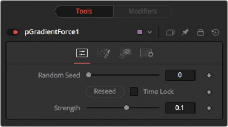
< Previous | Contents | Next >

The pFriction controls
The Random Seed slider and Randomize button are presented whenever a Fusion node relies on a random result. Two nodes with the same seed values will produce the same random results. Click the Randomize button to randomly select a new seed value, or adjust the slider to manually select a new seed value.
This value represents the Friction force applied to the particle’s Velocity. The larger the value, the greater the friction, thus slowing down the particle.
This value represents the Friction force applied to the particle’s Rotation or Spin. The larger the value, the greater the friction, thus slowing down the rotation of the particle.
Common Controls
![]()
The Conditions, Style, Region, and Settings tabs are common to all Particle nodes, so their descriptions can be found in “The Common Controls” section at the end of this chapter.
pGradientForce [pGF]

The pGradient Force node
pGradient Force Node Introduction
The particles are affected by a force generated by the gradients in the alpha values of the input image. Particles will accelerate along the gradient, moving from white to black (high values to low values).
This node can be used to give particles the appearance of moving downhill or following the contour of a provided shape.
Inputs
The pGradient Force node accepts two inputs: the default orange input from a particle node and one from a bitmap image with an alpha channel gradient. A magenta or teal bitmap or mesh input appears on the node when you set the Region menu in the Region tab to either Bitmap or Mesh.
— Input: The orange input takes the output of other particle nodes.
— Input: The green input takes the 2D image that contains the alpha channel gradient.
— Region: The magenta or teal region input takes a 2D image or a 3D mesh depending on whether you set the Region menu to Bitmap or Mesh. The color of the input is determined by whichever is selected first in the menu. The 3D mesh or a selectable channel from the bitmap defines the area where the gradient force occurs.
Basic Node Setup
The pGradient Force node is placed in between the pEmitter and pRender nodes. A Fast Noise node is used to create the alpha gradient used to modify the velocity of the particles.

A pGradient Force node using a Fast Noise node as the gradient to modify the particles’ motion
![]()
Inspector

The pGradient Force controls
The Random Seed slider and Randomize button are presented whenever a Fusion node relies on a random result.
Two nodes with the same seed values will produce the same random results. Click the Randomize button to randomly select a new seed value, or adjust the slider to manually select a new seed value.